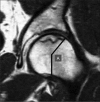Which Osteotomy for Osteonecrosis of the Femoral Head and Which Patient for the Osteotomy?
- PMID: 31156763
- PMCID: PMC6526125
- DOI: 10.4055/cios.2019.11.2.137
Which Osteotomy for Osteonecrosis of the Femoral Head and Which Patient for the Osteotomy?
Abstract
Transtrochanteric curved varus osteotomy (TCVO) and transtrochanteric rotational osteotomy (TRO) are joint-preserving procedures for osteonecrosis of the femoral head. The purpose of this review is to provide up-to-date guidelines for the osteotomies. One retrospective comparison revealed that TCVO has shorter operation time, less bleeding, lower incidence of osteophyte formation, and lower rate of secondary collapse. To obtain successful results of the osteotomy, the patient should be younger than 40 years and should have a body mass index of less than 24 kg/m2. The osteotomy should be performed in early stages of femoral head osteonecrosis before marked collapse of the femoral head. The patient should have a medium-size lesion and an enough viable bone to restore the intact articular surface and subchondral bone in the weight-bearing area.
Keywords: Femur head necrosis; Osteotomy.
Conflict of interest statement
CONFLICT OF INTEREST: No potential conflict of interest relevant to this article was reported.
Figures






Similar articles
-
Comparison of Surgical Parameters and Results between Curved Varus Osteotomy and Rotational Osteotomy for Osteonecrosis of the Femoral Head.Clin Orthop Surg. 2017 Jun;9(2):160-168. doi: 10.4055/cios.2017.9.2.160. Epub 2017 May 8. Clin Orthop Surg. 2017. PMID: 28567217 Free PMC article.
-
Effects of age and body mass index on the results of transtrochanteric rotational osteotomy for femoral head osteonecrosis: surgical technique.J Bone Joint Surg Am. 2011 Mar;93 Suppl 1:75-84. doi: 10.2106/JBJS.J.01215. J Bone Joint Surg Am. 2011. PMID: 21411688
-
Progressive collapse of transposed necrotic area after transtrochanteric rotational osteotomy for osteonecrosis of the femoral head induces osteoarthritic change. Mid-term results of transtrochanteric rotational osteotomy for osteonecrosis of the femoral head.Arch Orthop Trauma Surg. 2004 Mar;124(2):77-81. doi: 10.1007/s00402-003-0610-0. Epub 2003 Dec 5. Arch Orthop Trauma Surg. 2004. PMID: 14658077
-
Total hip arthroplasty after failed transtrochanteric rotational osteotomy for osteonecrosis of the femoral head: A systematic review and meta-analysis.Orthop Traumatol Surg Res. 2018 Dec;104(8):1163-1170. doi: 10.1016/j.otsr.2018.06.019. Epub 2018 Oct 4. Orthop Traumatol Surg Res. 2018. PMID: 30293751
-
[Transtrochanteric rotational osteotomy for the treatment of non-traumatic osteonecrosis of the femoral head].Clin Calcium. 2007 Jun;17(6):923-30. Clin Calcium. 2007. PMID: 17548933 Review. Japanese.
Cited by
-
The efficacy of Denosumab in the treatment of femoral head osteonecrosis: a retrospective comparative study.Sci Rep. 2024 Feb 20;14(1):4140. doi: 10.1038/s41598-024-54685-7. Sci Rep. 2024. PMID: 38374383 Free PMC article.
-
Femoral neck rotational osteotomy: a modified method for treating necrotic femoral heads with large and laterally located lesions.J Hip Preserv Surg. 2021 Apr 1;7(4):713-720. doi: 10.1093/jhps/hnab016. eCollection 2020 Dec. J Hip Preserv Surg. 2021. PMID: 34377514 Free PMC article.
-
Bilateral same-day transtrochanteric rotational osteotomy using computed tomography-based navigation: a case report.BMC Musculoskelet Disord. 2025 Mar 11;26(1):235. doi: 10.1186/s12891-025-08463-9. BMC Musculoskelet Disord. 2025. PMID: 40069642 Free PMC article.
-
Evaluation of the long-term patient-reported outcomes after hip arthroplasty or joint preserving with Sugioka femoral osteotomy in patients with femoral head osteonecrosis.Int Orthop. 2024 May;48(5):1201-1208. doi: 10.1007/s00264-024-06118-3. Epub 2024 Feb 20. Int Orthop. 2024. PMID: 38376531 Free PMC article.
-
Advancements in 3D printing technologies for personalized treatment of osteonecrosis of the femoral head.Mater Today Bio. 2025 Feb 4;31:101531. doi: 10.1016/j.mtbio.2025.101531. eCollection 2025 Apr. Mater Today Bio. 2025. PMID: 40026627 Free PMC article. Review.
References
-
- Gutierrez F, Padilla S, Masia M, et al. Osteonecrosis in patients infected with HIV: clinical epidemiology and natural history in a large case series from Spain. J Acquir Immune Defic Syndr. 2006;42(3):286–292. - PubMed
-
- Shimizu K, Moriya H, Akita T, Sakamoto M, Suguro T. Prediction of collapse with magnetic resonance imaging of avascular necrosis of the femoral head. J Bone Joint Surg Am. 1994;76(2):215–223. - PubMed
-
- Shibatani M, Fujioka M, Arai Y, et al. Degree of corticosteroid treatment within the first 2 months of renal transplantation has a strong influence on the incidence of osteonecrosis of the femoral head. Acta Orthop. 2008;79(5):631–636. - PubMed
-
- Shigemura T, Nakamura J, Kishida S, et al. Incidence of osteonecrosis associated with corticosteroid therapy among different underlying diseases: prospective MRI study. Rheumatology (Oxford) 2011;50(11):2023–2028. - PubMed
-
- Arlet J. Nontraumatic avascular necrosis of the femoral head: past, present, and future. Clin Orthop Relat Res. 1992;(277):12–21. - PubMed
Publication types
MeSH terms
LinkOut - more resources
Full Text Sources

